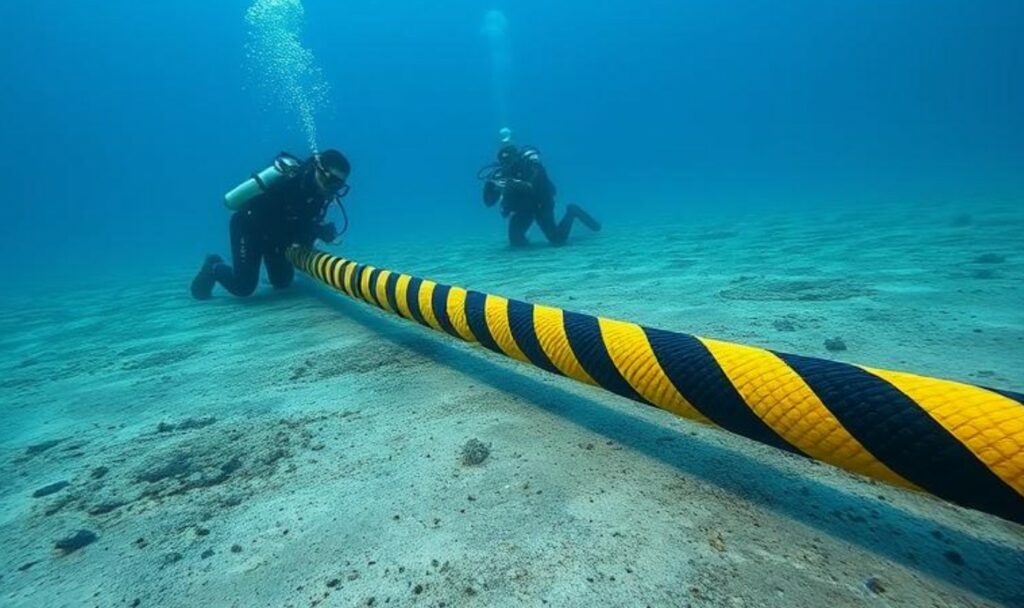
Over 1.2 million kilometers of fiber optic cables lie on the ocean floor, long considered solely part of a global telecommunications network. However, distributed acoustic sensing (DAS) technology , rapidly emerging from the experimental stage, is opening up a fundamentally new field : the use of these lines for underwater monitoring and anti-submarine warfare. What until recently seemed like a hypothesis is already beginning to materialize in concrete military developments.
DAS transforms a conventional fiber optic cable into a continuous chain of sensitive acoustic sensors. When a short pulse of laser light passes through the fiber, the reflected signals are modified by tiny vibrations, like the noise of a submarine propeller or the acoustic wave from an explosion.
Automatic analysis algorithms not only record these variations, but also determine the direction and nature of the source. The result is a passive listening system capable of covering vast maritime spaces, yet imperceptible and more cost-effective than traditional hydrophones or active sonar systems.
Tests have confirmed that DAS is equally effective in both coastal and deep-sea areas. The technology has applications beyond military: it can detect cable access attempts, record underwater seismic activity, and detect signs of illegal activity on the seabed.
When combined with artificial intelligence, these systems can compare acoustic signatures with GPS or AIS data, enabling the classification of vessels and underwater objects.
Several countries are already integrating DAS into their defense infrastructure. In the United States, the information collected from the cables is fed into combat management systems and compared with that from P-8A Poseidon naval aircraft and autonomous underwater vehicles. Artificial intelligence models are also being developed to improve recognition accuracy.
In the UK, the system is being trialled as part of a programme to protect submarine communications . The Ministry of Defence is working with telecommunications operators in the North Atlantic and the North Sea, testing the DAS for cable monitoring and tracking potential submarine activity.
Other countries are also actively exploring the potential of this technology. The Netherlands has already begun continuous monitoring of the North Sea using existing cables. Norway is exploring monitoring scenarios along Arctic shipping lanes, and Germany is evaluating DAS as part of its maritime strategy. The European Union is supporting developments in this area through the Horizon program, including projects on coastal surveillance and the protection of critical infrastructure.
As part of the AUKUS alliance, Australia, the United States, and the United Kingdom are developing DAS integration with unmanned underwater platforms and AI solutions for low-noise submarine tracking. Project participants plan to deploy a distributed sensor network integrated with autonomous tracking systems throughout the Indo-Pacific region.
Potential adversaries are also interested in this technology. China, which operates one of the largest undersea cable networks in the region, is, according to analysts, testing DAS to track interference and monitor traffic. Russia, for its part, has repeatedly expressed concern about such developments in the Arctic and the Baltics, viewing them as a threat to the secrecy of its submarine operations. In this context, incidents involving damage to cable lines have become more frequent: unexplained breaks and suspicious activity are being recorded in areas along strategic routes.
The method’s main advantage remains the ability to use existing cables, allowing for rapid scalability without significant infrastructure investments. However, this advantage also poses challenges: the incoming data volumes are colossal, and without effective filtering and interpretation algorithms, they are of little practical use. There is also the issue of noise immunity: attempts to suppress, mimic, or physically disable individual sections of the cable network are possible.
Follow us on Google News to receive daily updates on cybersecurity. Contact us if you would like to report news, insights or content for publication.
